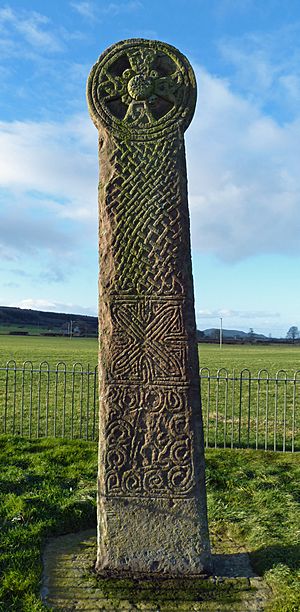Maen Achwyfan Cross facts for kids
Quick facts for kids Maen Achwyfan Cross |
|
|---|---|

"the tallest Wheel-Cross in Britain"
|
|
| Type | Cross |
| Location | Whitford, Flintshire |
| Built | 10th/11th century |
| Governing body | Cadw |
| Official name: Maen Achwyfan | |
| Reference no. | FL005 |
| Lua error in Module:Location_map at line 420: attempt to index field 'wikibase' (a nil value). | |
The Maen Achwyfan Cross is a very old stone cross found near the village of Whitford in Flintshire, Wales. It was made a long, long time ago, around the late 900s or early 1000s. This amazing cross stands about 3.4 meters (or 11 feet) tall, making it the tallest "wheel cross" in all of Britain! It's also a special protected site called a Scheduled monument.
Contents
History of the Maen Achwyfan Cross
The name "Maen Achwyfan" means "the stone of [Saint] Cwyfan." This name was given by Cadw, which is the Welsh government's group that looks after historic places. They believe the cross was made during the early Medieval period.
Experts like Edward Hubbard think the cross was carved between the late 900s and early 1000s. It is made from one huge piece of stone. Its impressive height makes it the tallest "wheel cross" in Britain.
What Does the Cross Look Like?
The top part of the cross is shaped like a wheel. It has round bumps, called bosses, on both sides. The long middle part of the cross, called the shaft, is covered in cool designs. You can see patterns of Celtic knotwork. There are also carvings of people and animals.
Sadly, after so many years, some of these pictures are now hard to see.
Viking Influence on the Cross
The designs on the Maen Achwyfan Cross show signs of Viking art. This is because Vikings often raided the coast of North Wales around the time the cross was made. Their unique style influenced local artists.
Where to Find the Maen Achwyfan Cross
This ancient cross stands in a field. You can find it just north of the village of Whitford. Because it is so important, it is protected as a Scheduled monument. This means it's a special site that must be preserved for future generations.

